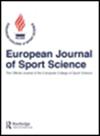Using accelerometry to classify physical activity intensity in older adults: What is the optimal wear-site?
IF 3
3区 医学
Q2 SPORT SCIENCES
引用次数: 11
Abstract
Abstract This study aimed to determine the optimal accelerometer wear-site specific cut-points for discrimination of the sedentary time, light physical activity and moderate-to-vigorous physical activity (MVPA) in older adults. Twenty-three adults (14 females) aged 55–77 years wore a GENEActiv accelerometer on their non-dominant wrist, dominant wrist, waist and dominant ankle whilst undertaking eight, five-minute bouts of activity: lay supine, seated reading, slow walking, medium walking, fast walking, folding laundry, sweeping and stationary cycling. VO2 was assessed concurrently using indirect calorimetry. Receiver-operating-characteristic (ROC) analyses were used to derive wear-site specific cut-points for classifying intensity. Indirect calorimetry indicated that being lay supine and seated reading were classified as sedentary (<1.5 METs), laundry as light (1.51–2.99 METs) and sweeping, slow, medium and fast walking and cycling all classified as moderate intensity (>3 METs). Areas under ROC curves indicated that the classification of sedentary activity was good for the non-dominant wrist and excellent for all other wear sites. Classification of MVPA was excellent for the waist and ankle, good for the waist and poor for the dominant and non-dominant wrists. Overall, the ankle location performed better than in other locations. Ankle-worn accelerometry appears to provide the most suitable wear-site to discriminate between sedentary time and MVPA in older adults.使用加速度计对老年人的体力活动强度进行分类:最佳磨损部位是什么?
摘要:本研究旨在确定老年人久坐时间、轻度体力活动和中高强度体力活动(MVPA)的最佳加速度计磨损部位切割点。23名55-77岁的成年人(14名女性)在他们的非优势手腕、优势手腕、腰部和优势脚踝上佩戴geneactive加速度计,同时进行8次5分钟的活动:仰卧、坐着阅读、慢走、中走、快走、折叠衣服、扫地和固定骑自行车。同时使用间接量热法评估VO2。接受者工作特征(ROC)分析被用来得出磨损部位的特定切割点来分类强度。间接量热法表明,仰卧和坐着阅读被归类为久坐(3 METs)。ROC曲线下的区域表明,久坐活动的分类对非主导手腕很好,对所有其他佩戴部位都很好。MVPA的分级对腰、踝关节非常好,对腰部很好,对优势腕和非优势腕很差。总的来说,踝关节位置比其他位置表现更好。踝关节佩戴的加速度计似乎是区分老年人久坐时间和MVPA最合适的佩戴部位。
本文章由计算机程序翻译,如有差异,请以英文原文为准。
求助全文
约1分钟内获得全文
求助全文
来源期刊
CiteScore
6.60
自引率
3.10%
发文量
153
审稿时长
6-12 weeks
期刊介绍:
The European Journal of Sport Science (EJSS) is the official Medline- and Thomson Reuters-listed journal of the European College of Sport Science. The editorial policy of the Journal pursues the multi-disciplinary aims of the College: to promote the highest standards of scientific study and scholarship in respect of the following fields: (a) Applied Sport Sciences; (b) Biomechanics and Motor Control; c) Physiology and Nutrition; (d) Psychology, Social Sciences and Humanities and (e) Sports and Exercise Medicine and Health.

 求助内容:
求助内容: 应助结果提醒方式:
应助结果提醒方式:


